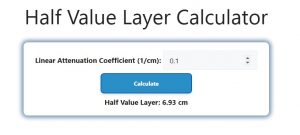About Half Value Layer Calculator (Formula)
The Half Value Layer (HVL) Calculator is a useful tool in fields such as radiology, nuclear medicine, and radiation protection. HVL is defined as the thickness of a material required to reduce the intensity of radiation to half its original value. Understanding HVL is essential for professionals dealing with radiation, as it helps determine the necessary shielding to protect individuals and sensitive equipment from harmful radiation exposure. This article will provide insight into the HVL calculation formula, instructions on how to use the calculator, practical examples, and answers to frequently asked questions.
Formula
The formula used in the Half Value Layer Calculator is:
HVL = 0.693 / u
Where:
- HVL = Half Value Layer (thickness of material)
- u = Linear attenuation coefficient of the material
How to Use
Using the Half Value Layer Calculator is straightforward:
- Determine the Linear Attenuation Coefficient (u): This value is specific to the material and can often be found in literature or databases related to radiation physics. It is usually expressed in units of cm⁻¹.
- Input the Value: Enter the value of the linear attenuation coefficient into the calculator.
- Calculate: Click the “Calculate” button to obtain the Half Value Layer.
Example
Let’s consider an example where we want to calculate the Half Value Layer for a material with a linear attenuation coefficient (u) of 0.1 cm⁻¹.
- Linear Attenuation Coefficient (u) = 0.1 cm⁻¹
Using the formula:
HVL = 0.693 / 0.1
HVL = 6.93 cm
Thus, the Half Value Layer for this material is 6.93 cm.

FAQs
1. What is a Half Value Layer (HVL)?
HVL is the thickness of a material required to reduce the intensity of radiation by half.
2. Why is HVL important?
It helps in determining the necessary thickness of materials for effective radiation shielding.
3. How is the linear attenuation coefficient (u) determined?
The linear attenuation coefficient can be measured experimentally or obtained from scientific literature.
4. What units are used for HVL?
HVL is typically measured in centimeters (cm) or millimeters (mm).
5. Can this calculator be used for different types of radiation?
Yes, it can be applied to various types of radiation, including alpha, beta, and gamma radiation.
6. How does density affect HVL?
Denser materials generally have higher linear attenuation coefficients, leading to smaller HVLs.
7. Is the HVL the same for all materials?
No, different materials have different linear attenuation coefficients and thus different HVLs.
8. Can the HVL be used in medical applications?
Yes, it is crucial in fields like radiology and radiation therapy for determining safe exposure levels.
9. What is the significance of a low HVL?
A low HVL indicates that less material is needed to shield against radiation, which can be beneficial in design.
10. How do I find the linear attenuation coefficient for a specific material?
You can refer to radiation physics textbooks, research papers, or databases that provide this information.
11. What happens if I input a negative value for u?
Negative values for u are nonsensical in this context, as they do not represent physical properties of materials.
12. How is HVL related to the concept of exponential decay?
HVL is derived from the exponential decay of radiation intensity as it passes through matter.
13. Can HVL be used for neutron radiation?
Yes, but the appropriate linear attenuation coefficients for neutrons must be used.
14. Is there a relationship between HVL and the overall thickness of shielding material?
Yes, multiple layers of shielding can be calculated using HVLs to achieve desired radiation levels.
15. How often should shielding calculations be reviewed?
Shielding designs should be reviewed periodically, especially when changes in radiation sources occur.
16. Can this calculator help in designing radiation therapy equipment?
Yes, it is beneficial in designing and optimizing shielding in radiotherapy.
17. What materials are commonly used for radiation shielding?
Common shielding materials include lead, concrete, and certain plastics.
18. Does the HVL change with energy levels of radiation?
Yes, the HVL can vary based on the energy of the radiation being measured.
19. Can HVL calculations be used in safety protocols?
Yes, they are essential for developing safety protocols in environments with radiation exposure.
20. How does temperature affect HVL?
Temperature generally does not affect HVL significantly; however, changes in material properties at extreme temperatures may influence it.
Conclusion
The Half Value Layer Calculator is a crucial tool for anyone working with or studying radiation. By understanding how to calculate HVL using the linear attenuation coefficient, professionals can ensure adequate protection against harmful radiation. Whether in medical applications, industrial settings, or research environments, accurate HVL calculations contribute significantly to safety and efficacy in radiation management.